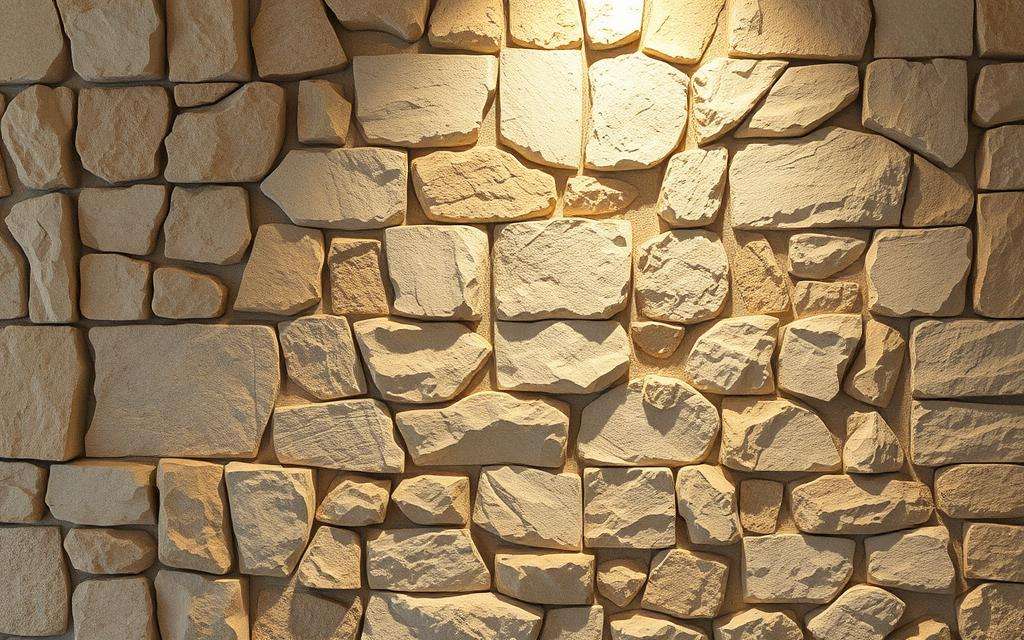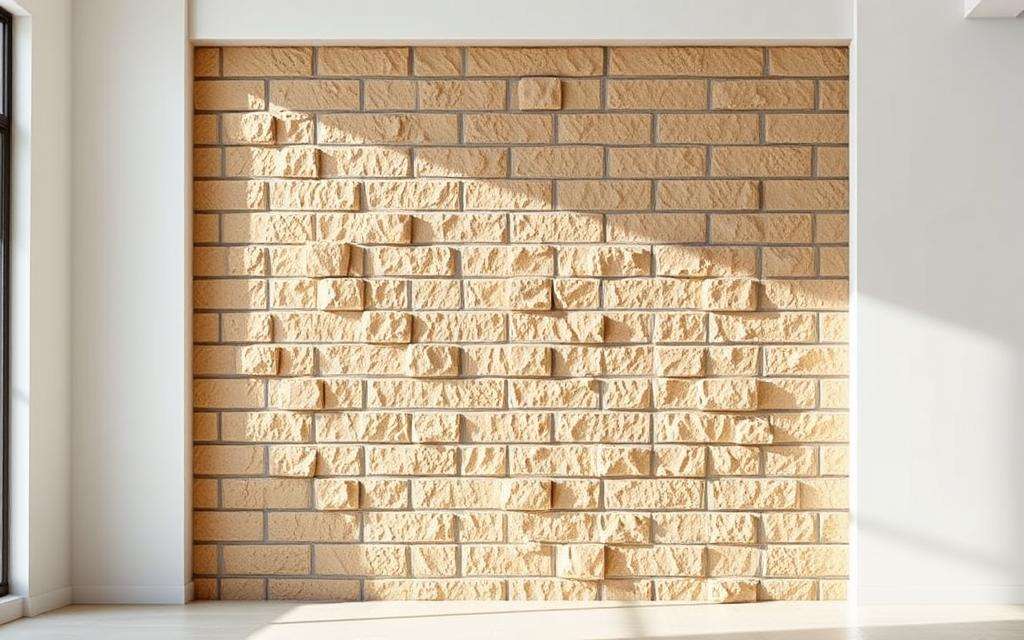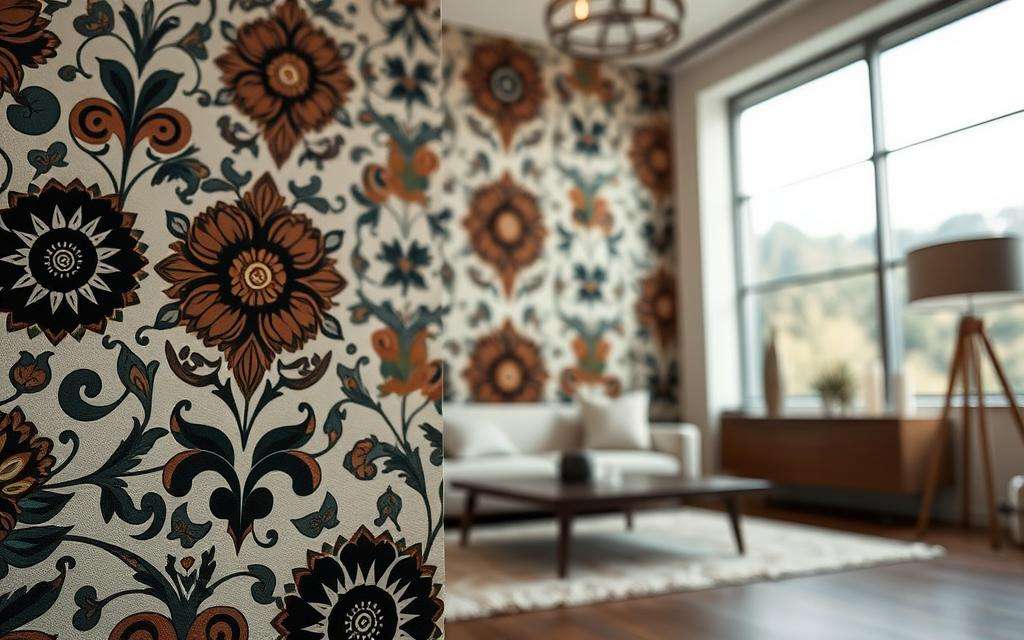Decorative Stone Wall : Can a decorative stone wall mix rustic charm with sleek style? Many think of stone as old castles or cabins. But today, homeowners see how it fits modern homes. Stone walls add texture and beauty to any space. Stone has been key in building for thousands of years. Now, it’s changing in modern homes. You can pick from natural stones like limestone or go for faux stone panels. These walls last long, look great, and fit any room.
Key Takeaways
- Stone walls mix old charm with new style.
- You can pick from real or fake stone, depending on what you want.
- They make your home look better inside and out, with little care needed.
- Limestone and sandstone are favorites for their looks and strength.
- Now, you can find stone that’s good for the planet too.
The Timeless Appeal of Decorative Stone Walls
Stone has been a cornerstone of architecture for thousands of years. It has shaped structures that stand long after their creators are gone. Today, stone wall design trends mix old traditions with new needs. From ancient Roman aqueducts to grand castles, decorative stone wall elements show strength and lasting power.
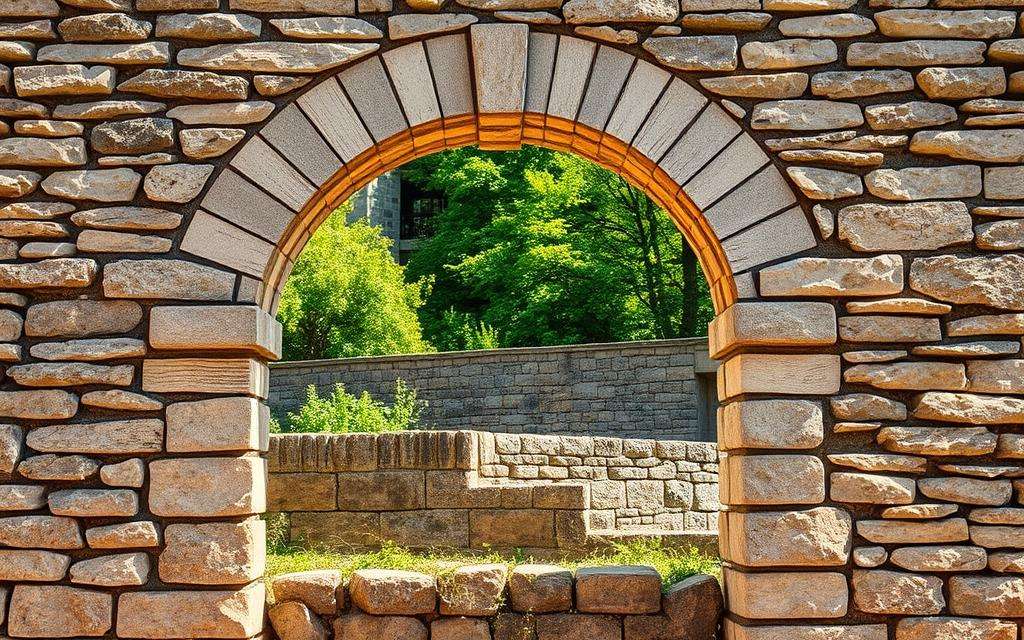
Historical Significance of Stone in Architecture
Early civilizations picked stone for its lasting quality. Medieval European cathedrals used limestone for their height. Native American pueblos chose sandstone for its climate resistance. These examples show stone’s role as both a material and a cultural symbol.
Why Stone Continues to Captivate Homeowners
Today, homeowners love stone for its feel. The rough texture of fieldstone or the smooth look of cut granite makes spaces feel both natural and elegant. Decorative stone wall designs now mix rustic and minimalist styles, showing stone’s versatility.
The Durability Factor: Why Stone Stands the Test of Time
Stone’s unmatched durability comes from its natural makeup. Unlike fake materials, natural stone:
- Resists fire damage better than wood or plastic
- Maintains structural integrity in freeze-thaw cycles
- Requires minimal maintenance over decades
Architects like Frank Lloyd Wright used stone for its beauty and practicality. With the right setup, a stone wall can last for generations, making it a valuable investment.
Types of Decorative Stone Wall Materials
Choosing the right material for your decorative stone wall starts with understanding available options. There are three main categories: natural stone, manufactured stone veneer, and faux stone products. Each offers unique aesthetics and practical benefits.
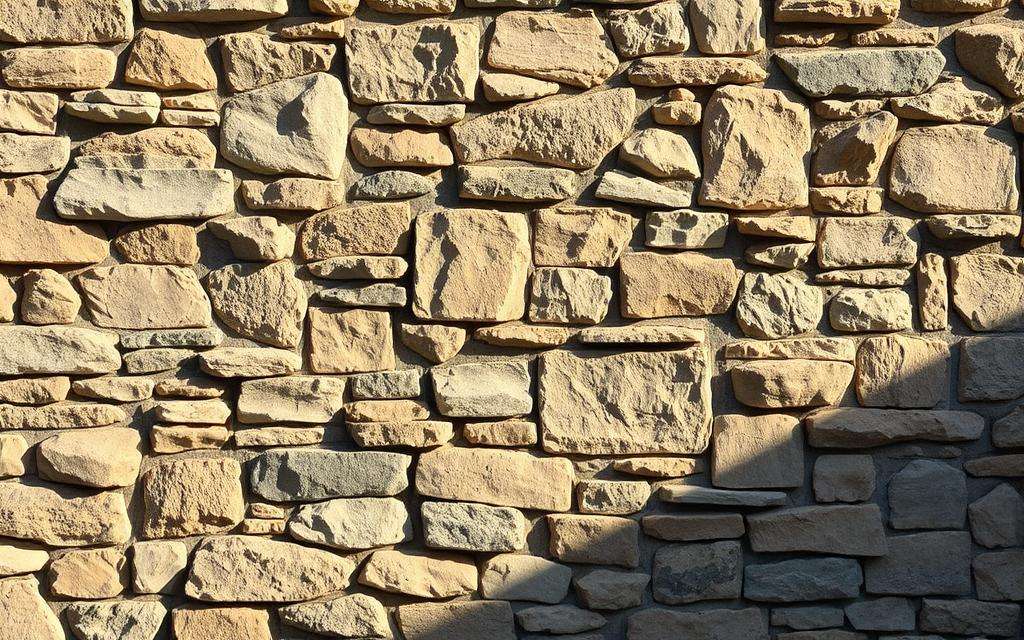
- Natural stone wall: Harvested directly from quarries, options like granite, limestone, and sandstone offer organic textures and color variations. These materials provide durability and timeless appeal, though installation may require professional expertise. Sustainability is a plus when sourced responsibly.
- Manufactured stone veneer: Engineered stone cladding mimics natural stone but with lighter weight and easier handling. This option balances authenticity with affordability, making it ideal for DIY projects or large-scale applications.
- Faux stone products: Polyurethane or concrete composites replicate stone visuals at a lower cost. These are low-maintenance and versatile, perfect for modern or budget-focused designs.
Cost, durability, and environmental impact vary widely. For instance, natural stone delivers unmatched longevity but demands higher initial investment. Manufactured stone cladding reduces labor costs while retaining visual authenticity. Faux options prioritize ease of use but may lack the natural stone wall’s tactile depth.
Homeowners should weigh these factors alongside their design vision. The next sections explore natural stone varieties in detail, guiding decisions further.
Natural Stone Walls: Beauty in Authenticity
Homeowners looking for real elegance find it in natural stone walls. Each stone has its own special qualities for both inside and outside spaces.
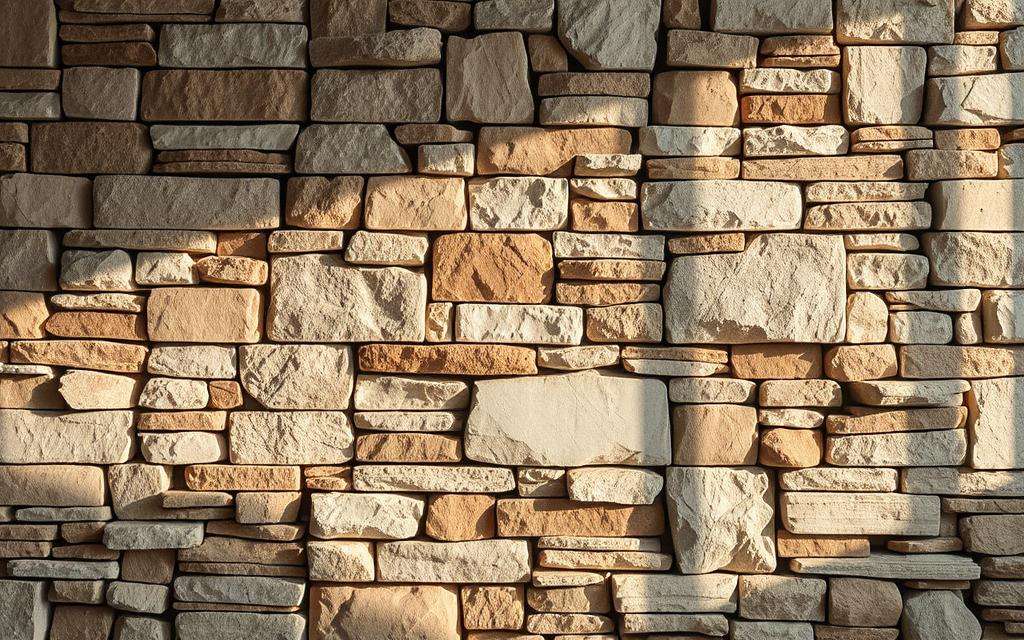
Limestone, Granite, and Sandstone Options
Limestone gives a smooth look, great for modern or classic designs. Granite is durable, perfect for busy areas like patios. Sandstone adds a warm, earthy feel, ideal for rustic homes. Prices vary: limestone starts at $15-$30 per sq. ft., while granite can go up to $50+ based on where it’s from.
- Limestone: Soft colors, easy carving
- Granite: Heat and stain resistance
- Sandstone: Porous texture, sun-bleached hues
Fieldstone and Ledgestone Variations
Fieldstone has weathered edges for a farmhouse look. Ledgestone’s layered patterns remind us of ancient cliffs. The Midwest offers gray fieldstone, while the Southwest has red and tan ledgestone. These stones fit well with colonial, log cabin, or mountain lodge styles.
“Regional stone ensures architectural harmony with local landscapes.”
Sourcing Ethical and Sustainable Options
Choose suppliers with certifications like the Natural Stone Council for ethical practices. Opt for local quarries to reduce carbon emissions. Look for FSC (Forest Stewardship Council) or NAHB (National Association of Home Builders) sustainability seals. Eco-friendly choices keep beauty without harming the environment.
Stone Veneer Walls: The Modern Alternative
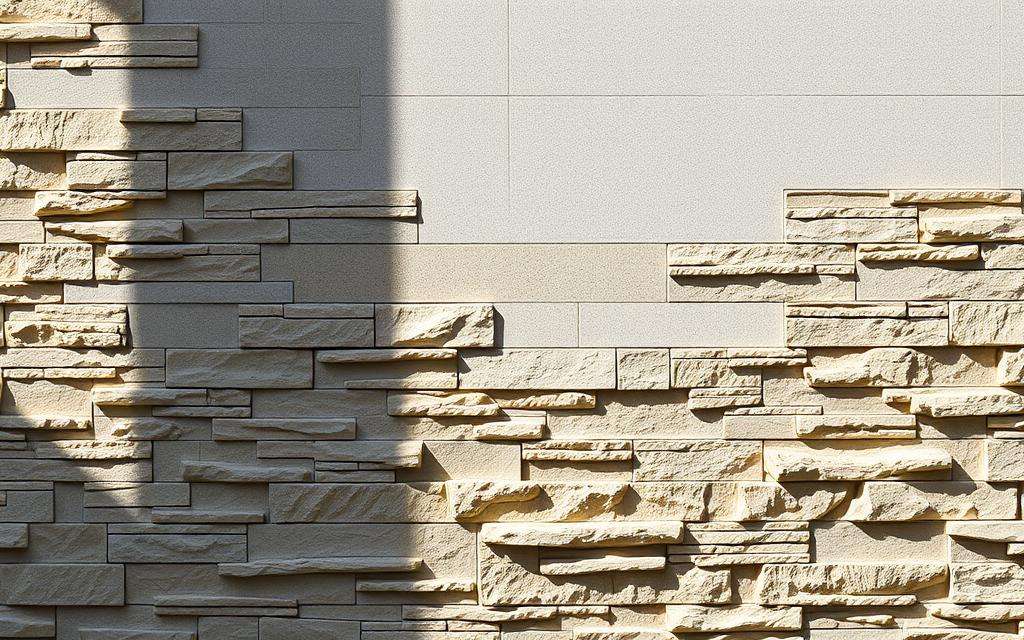
Stone veneer walls combine the look of real stone with ease of use. They use thin slices of natural stone attached to a backing. This makes them lighter and easier to install than full stone walls.
- Manufacturing: Real stone slabs are cut into 1–2 inch sections, reducing weight by up to 80%.
- Cost Efficiency: Installation costs drop by 40–60% compared to full stone projects.
- Installation Flexibility
| Type | Material | Appearance | Cost |
|---|---|---|---|
| Natural Stone Veneer | Real stone chips/adhesives | Authentic grain patterns | $8–$15 per sq. ft. |
| Cultured Stone Veneer | Concrete + stone dust | Semi-realistic texture | $4–$9 per sq. ft. |
Stone cladding systems include pre-finished panels for quick application. Modern adhesives and mesh-backed units make DIY projects easier. Waterproofing membranes ensure durability outdoors. Veneer adds the beauty of natural stone to any area, saving on labor and cost.
Faux Stone Wall Solutions: When to Consider Them
Modern technology has made faux stone walls a great choice instead of real stone. They look like real stone but cost less and are easier to install. People who want the look of stone without the hard work choose these options.
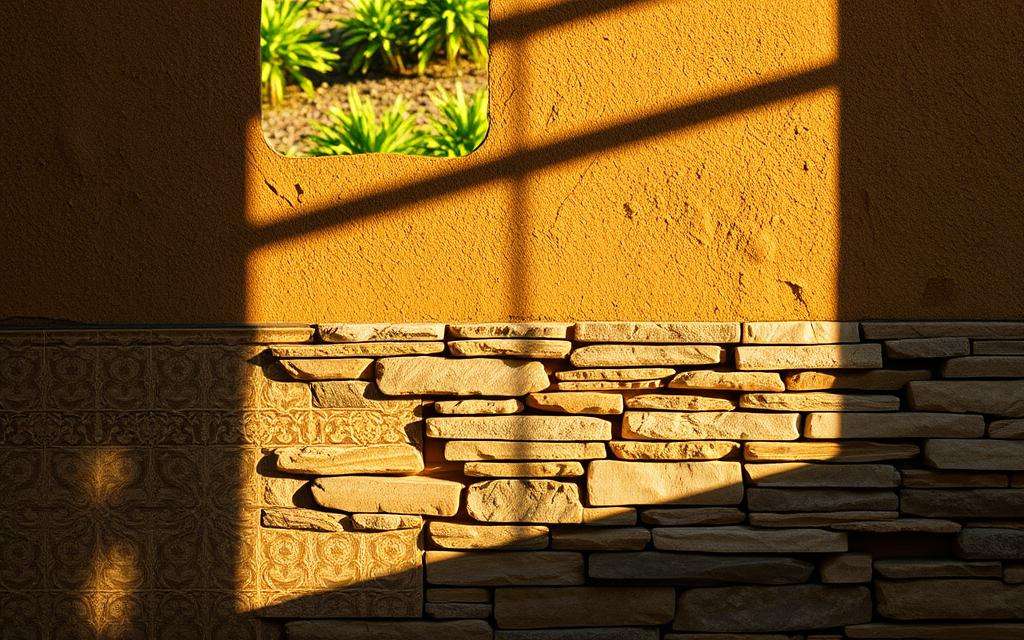
Benefits of Manufactured Stone
- Cost savings: Up to 60% cheaper than natural stone installations
- Uniform appearance: Consistent texture and color batches
- Lightweight materials: Reduces structural load demands
Comparing Quality: How to Identify Premium Faux Stone
| Feature | Premium Quality | Lower Quality |
|---|---|---|
| Color Variation | Subtle natural gradients | Single-tone dominance |
| Texture Depth | Multi-layered embossing | Flat surface replication |
| Mold Patterns | Randomized stone shapes | Repeating patterns |
Installation Advantages of Lightweight Options
Lightweight faux stone makes installation easier. It doesn’t need heavy equipment. Most systems use panels that snap together. You don’t need mortar or special tools for many modern systems. Here’s how they compare:
| Aspect | Traditional Stone | Faux Stone Wall |
|---|---|---|
| Installation Time | 7-10 days | 1-3 days |
| Installer Skill | Masonry certification | Homeowner capability |
| Structural Support | Reinforced foundations | Standard drywall |
Interior Stone Wall Design Ideas
Transform spaces with interior stone wall design to blend elegance and practicality. Stone adds depth without overpowering. Here’s how to craft spaces that balance style and purpose.
Statement Walls for Living Spaces
Turn living areas into focal points with stone. Use textured limestone for fireplace surrounds or slate as a backdrop for built-in shelves. Soft lighting highlights natural patterns.
Neutral tones like beige or gray harmonize with open layouts. For entryways, a partial stone panel creates arrival impact without overwhelming small spaces.
Kitchen and Bathroom Applications
- Kitchens: Install travertine backsplashes to contrast with cabinetry or wrap stone around a freestanding range hood.
- Bathrooms: Opt for polished marble in shower niches or use stacked stone on vanity walls for spa vibes. Seal grout annually to resist moisture.
Mixing Stone with Other Materials
“Pairing stone with warm wood tones grounds modern spaces,” says architect Clara Morgan. “Metal accents like bronze hardware add contrast.”
Combine slate with oak floors in rustic lofts or use travertine tiles adjacent to glass shower enclosures. For industrial designs, contrast concrete countertops with granite wall panels. Always test samples for color and texture cohesion.
Exterior Stone Wall Applications and Benefits
Exterior stone walls turn homes into stunning works of art. They bring a rustic or modern look, making them perfect for any home. These walls not only look great but also add value to your property.
- Facades: Use natural stone to clad entire walls or accent specific areas like gables or entryways.
- Entryways: Frame doors with stacked stone or smooth veneers to create welcoming focal points.
- Landscaping: Retaining walls and garden borders add structural integrity while blending with outdoor spaces.
- Outdoor living: Wrap patios or fire pits in stone for weather-resistant, low-maintenance surfaces.
Choosing the right stone depends on your climate. In cold areas, granite is a good choice because it doesn’t get damaged by freezing and thawing. Near the coast, limestone is better because it resists salt. In humid places, sandstone is a good option because it breathes.
Match the stone with your home’s style. Fieldstone looks great with log cabins, while cut stone fits modern homes. Make sure the size of the stones matches your home’s size. Big stones are best for large homes, and smaller ones work well for smaller homes.
“A well-designed exterior stone wall can increase property value by up to 15%,” according to the National Association of Realtors.
Stone walls are easy to take care of, unlike wood or composite materials. They last for many years with the right installation. Whether it’s a retaining wall or a porch accent, an exterior stone wall is a smart choice for both looks and function.
The Stone Wall Installation Process
Setting up a stone wall needs careful planning, whether you do it yourself or get a pro. First, figure out your skill level and how complex the project is. This will help you decide what to do.
DIY vs. Professional: Key Factors
If you’re new, you might try a DIY veneer project. But, building a real stone wall needs a lot of skill. Think about these points:
- Skill Level: If you need to make complex cuts or build a wall that holds weight, you’ll need masonry training.
- Cost: Doing it yourself might save money upfront. But, if you make mistakes, it could cost a lot more.
- Time: Pros work faster and do a better job.
Tools and Materials Checklist
Here’s what you’ll need for stone wall installation:
| Category | Items Needed |
|---|---|
| Tools | Masonry saw, trowels, level, chisels |
| Materials | Adhesive (like Sika or Henkel), grout, moisture barriers |
| Safety | Safety goggles, gloves, dust mask |
Step-by-Step Overview
- Get the base ready: Clean the area and put in moisture barriers.
- Plan out the stones dry to see how they fit.
- Spread adhesive with a notched trowel.
- Put the stones in place, making sure they’re level.
- Grout the gaps after 24 hours.
Getting a pro for stone wall installation means they’ll make sure it’s anchored right and sloped correctly. Always check local building codes before you start.
Maintenance and Care for Your Decorative Stone Wall
Keeping your decorative stone wall or stone cladding looking great for years is easy. First, know what each material needs. For example, interior walls like kitchen backsplashes need just mild soap and water for cleaning. But, exterior stone cladding must face harsher weather, so it needs stronger care to fight off moss and stains.
- Interior care: Clean spills right away and don’t use rough sponges.
- Exterior care: Use a stiff brush and vinegar to clean off efflorescence.
- Sealing: Seal every 3-5 years to keep moisture out.
Stay away from harsh chemicals, as they can damage grout and etch stone. For algae, mix hydrogen peroxide with water. Check the joints every year; if mortar cracks, fix it to stop water damage. Professional cleaning every 5-7 years can remove tough stains.
“Neglecting annual inspections cuts a stone wall’s lifespan by 30%,” warns the Marble Institute of America.
Act quickly on stains. Use commercial cleaners for oil-based marks. Never use pressure washers on delicate stone veneer. Keep tools like soft brushes and pH-neutral cleaners where you can easily find them. With the right care, your decorative stone wall will be a lasting value in your home.
Conclusion: Elevating Your Home with Timeless Stone Beauty
Stone wall design combines lasting beauty with practical use. It lets homeowners change their spaces while keeping style and quality. You can choose from natural stone’s real texture or stone veneer’s cost-effective look.
Stone fits any style, from modern to rustic. It’s perfect for any home. Whether you want a rugged look or something sleek, stone makes it happen.
Choosing stone means picking a material that gets better with age. It’s easy to care for and stays beautiful for years. This makes it a smart choice for your home, adding value and making you happy.
Stone veneer walls offer a similar look to natural stone but cost less. This makes it great for big projects or small touches. It’s a way to add beauty to your home without breaking the bank.
Stone works well inside or outside your home. It lets you get creative with your design. Finding the right supplier or expert can help you find the perfect stone for your project.
With stone, you can create a space that lasts. It connects you to centuries of design while making your home inspiring every day.
FAQ
What are the differences between natural stone walls and stone veneer walls?
Natural stone walls use real stones and are very durable and beautiful. Stone veneer walls are thinner and made to look like real stone. They are lighter and easier to put up, making them popular.
How can I maintain my decorative stone wall?
Keeping your stone wall clean and sealed is key. Use the right cleaners and sealants. Check for stains or algae to keep it looking great.
Are faux stone walls a good alternative to natural stone?
Yes, faux stone walls are cheaper and lighter. They come in many styles and are great for DIY projects. Just make sure to pick high-quality ones for a real look.
Can I install a stone wall myself, or should I hire a professional?
DIY fans can tackle veneer walls, but complex projects need pros. Think about your skills and the project’s needs before you start.
What types of stone can be used for interior stone wall applications?
For inside walls, you can use limestone, granite, sandstone, fieldstone, and ledgestone. Each has its own look and fits different styles, making them versatile.
How does weather affect exterior stone walls?
Weather can really affect outdoor stone walls. Things like freezing, humidity, and salt can damage the stone. Choose stones that fit your local weather well.
Are there any environmental impacts associated with using natural stone?
Getting natural stone can harm the environment, like disrupting habitats and causing carbon emissions. But, stone from local quarries is better for the planet.
What is stone cladding, and how is it different from a stone wall?
Stone cladding is thin layers of stone over existing walls for a better look. It’s lighter and easier to install than full walls, making it more flexible for designs.
